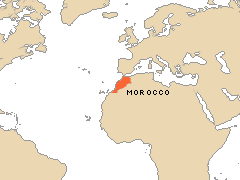
How do we know
An evaluation of the trachoma program was conducted by the London School of Hygiene and Tropical Medicine and the Ministry of Health of Morocco. The evaluation consisted of interviews with the program partners, field visits, questionnaires and interviews.Downloads
- Read the entire case study
(PDF | 132 K)
External Links
- Read about Morocco's success as the first country to complete the trachoma control campaign (PDF | 108k)
- Learn more about the International Trachoma Initiative
- Read the history of Morocco's fight against trachoma (PDF | 547k)
- Learn more about trachoma and the SAFE strategy
- View photo slide shows from Morocco, Tanzania and Ethiopia
- Read about combining operational research with the SAFE strategy to inform policy, planning, and implementation
Health Condition: Trachoma is the second leading cause of blindness in the world, and the number one cause of preventable blindness. More than 84 million people in 55 countries have trachoma. Economic development and improved hygiene have eliminated the disease from North America and Europe. But it plagues millions in hot, dry regions where access to clean water, sanitation, and health care is limited. In 1992, a national survey found that just over 5 percent of Morocco’s population had the blinding disease trachoma. Nearly all the cases were concentrated in five poor, rural provinces in the southeast of the country where 25,000 people showed a serious decline in vision due to trachoma, 625,000 needed treatment for inflammatory trachoma, and 40,000 urgently needed surgery.
Intervention or Program: In 1991, Morocco formed the National Blindness Control Program to eliminate trachoma by 2005. Between 1997 and 1999, the program implemented a new strategy called SAFE (surgery, antibiotics, face washing, and environmental change), giving Morocco the distinction as the first national-level test of the four-part strategy.
- Mobile teams have performed simple, inexpensive surgeries in small towns across the provinces;
- 4.3 million treatments of the antibiotic azithromycin have been distributed;
- Health education efforts promoting face washing and hygiene have been conducted; and
- Latrines have been constructed and safe drinking water supplied.
Impact: Overall, the prevalence of active disease in children under 10 has been reduced by 99 percent since 1997.
Cost and Cost-Effectiveness: The Moroccan government has provided the bulk of the financing for the program, with external support from the United Nations Children’s Fund and a public-private partnership called the International Trachoma Initiative. Through this partnership, the pharmaceutical company Pfizer has donated over $72 million worth of its antibiotic Zithromax®.

